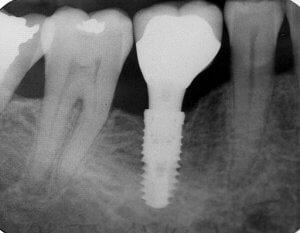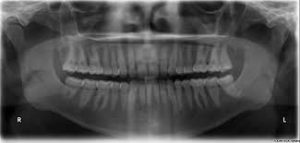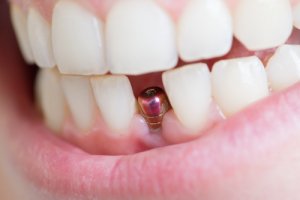Dental implants are the best way to replace missing teeth. That’s because they have a post that goes into your jaw that acts as a natural tooth root would. This makes eating and talking feel natural, and maintains the integrity of your jawbone.
So let’s find out all about dental implants, including the following information:
What are dental implants?
A dental implant is an artificial tooth root that the dentist surgically inserts into the jawbone. Teeth implants hold a prosthetic tooth in place. In this way, implants function in a similar way to a natural tooth root.
Many people use the term ‘implant’ to mean the entire replacement tooth, but it actually only refers to the part inserted into the bone. We’ll explain all the different components in just a moment.
Implants may be used in cases where the patient has had an accident which has caused them to lose one or more of their teeth. There are also some medical conditions that result in missing teeth. Other people choose to have implants for purely cosmetic reasons.
The result is artificial teeth that look, feel, and function just like natural teeth.
Who can have dental implants?
In order to be a good candidate for an implant, the patient should have strong, healthy gums and a jawbone that is capable of supporting the new root.
Patients who have underlying oral health problems like gingivitis, or who have experienced bone loss due to a tooth abscess may not be suitable for implant surgery, as you could end up with loose implants, or implants that show through your gums, requiring removal.
However, in many cases, it’s possible to carry out a bone graft to strengthen the jawbone before implants go in.
Mini implants
One alternative for patients who can’t have conventional implants is mini dental implants. These are similar in structure to their larger counterparts but have a thinner root, about the width of a toothpick. This means that less bone is needed to hold them in place.
If you have been told you can’t have implants because you have jawbone loss or your bone density is too low, even if you have osteoporosis, mini dental implants may still be an option. Read our osteoporosis and dental implants guide here. You can also read more about bone loss and dental implants.
An added benefit of mini dental implants is they can usually go in in a single visit—no need to wait three to six months for the implant to settle.
You can also read about getting implants with receding gums to learn more about your options.
Dental implants are a fantastic choice and an ideal selection when replacing a missing tooth or teeth. Providing the patient an ability to enjoy proper chewing and oral function — along with preserving the facial muscles — dental implants also ensure a patient smiles with ease and confidence.


The dental implant process requires two phases: a surgical phase and a restorative phase. Regarding the surgical phase, patients should be mindful of working with an oral surgeon who is well experienced, equipped with an abundance of training in the discipline.
If an implant is poorly or incorrectly placed it could potentially lead to permanent nerve damage, infection and more. It’s also important to ensure patients’ dental implants are high quality, as there’s great benefit to working with an implant that is FDA approved and research-backed to mitigate any adverse reactions during both surgery and recovery phases of the procedure.
Dr. Igal Elyassi, Wilshire Smile Studio
How much do they cost?
The cost ranges from $1,000 to $6,000 for a single implant, and can be around $40,000 for a full mouth. However, there are different ways to cover these costs — and we talk all about them in our full guide to dental implants cost.
You can also calculate the approximate price with our cost calculator:
Total estimated cost
And for insurance coverage for implants, you can get your free, no-obligation quote by filling in the form below:
[dental_insurance_form]
Types of dental implants and tooth reconstruction
There are two main types of dental implants.
The first is the endosteal implant. These are inserted directly into the jawbone and hold one or more artificial teeth in place via abutments. They look like small screws, either tapered or cylindrical.
The other is the subperiosteal implant. This implant has a metal base which is fitted under the gum tissue but above or on the jawbone.
The artificial teeth are fitted in the same way, to supports which protrude from the gums. This type is less common but is an alternative for patients with a shallow jawbone that won’t support endosteal implants.
The following animation shows the different components of an endosteal implant being placed:
Dental implant materials
There are different materials available for the part of the implant inserted into your jawbone, which functions like a tooth root.
Titanium implants are most common in best dental implants by many dental surgeons. This metal is incredibly strong and is biocompatible with your jawbone, meaning there should be no reaction and the bone naturally grows around it over time.
The implants are not made from pure titanium as this is too soft; instead, various alloys have been developed.


For people who don’t like the idea of having metal in their bodies, various ceramics and polymers are available.
By far the most common alternative to titanium is zirconia implants. Although this material contains traces of metal, it is classed as a ceramic.
Titanium implants
Because titanium has been in implants for much longer than zirconia, more studies demonstrate its safety, effectiveness and longevity. Many dentists, therefore, feel more comfortable recommending titanium.
There is also the matter of versatility. Titanium implants come in two parts: the implant and abutment. Because the dental implant abutment goes in separately, there is some flexibility to adjust the position of the crown on top.
Zirconia implants
Crowns can be made from porcelain, metal, or ceramic, like Emax crowns. Zirconia implants, on the other hand, usually don’t have a separate abutment.
Some studies suggest that zirconia, although extremely strong, is more susceptible to material flaws than titanium. Pores and micro-cracks in the material can cause the material to fracture, meaning zirconia implants have a slightly higher failure rate.
Finally, the typical cost of dental implants made from titanium is less than zirconia. All of these factors point towards titanium as the best option, unless you particularly want to avoid metal or you know you are allergic to any of the metals used in titanium alloys.
Still, you can discuss the options with your dentist and ask their advice if you have any concerns, and you can also read our guide to zirconia vs titanium implants to find out more.
Dentures vs. dental bridges vs. implants
Remember that an ‘implant’ is simply the artificial root inserted to hold replacement teeth in place, so we can now turn our attention to the different types of replacement tooth available.
The terminology can get a little confusing here since one word can refer to different things.
When a single tooth needs replacement, the implant will be fitted with an individual crown. This is different from the type of crown that repairs a broken tooth.
The non-implant alternative is a bridge which affixes to the two adjacent teeth and fills the gap. The downside of a traditional dental bridge is it requires healthy teeth to be shaved down. Read more about dentures vs implants.
Where two or more teeth in a row are missing, an implant bridge may suffice. Rather than inserting one implant for each tooth, just two implants support a row of three or four artificial teeth fused together.
In the video below Dr. Tamisha Denis goes into more detail about why she prefers implants to bridges:
If all the teeth in the jaw need to be replaced, denture implants may be the solution. These consist of a full set of plastic or porcelain teeth attached to a gum-colored acrylic base.
Whereas traditional dentures sit on the gum and are affixed with adhesive, implant-retained dentures clip onto fixed abutments and are much more sturdy.
Complete dental implants
Patients who have lost all their teeth may also consider a complete set of implants. Unlike implant dentures, these are permanent Many people prefer the idea of having fixed teeth rather than ones they have to remove for cleaning.
It’s usually not necessary to insert an individual root for each tooth since a single implant root is strong enough to support several teeth.
Solutions such as All-on-4 implants, G4 by Golpa implants, and All-on-X teeth implants allow a full set of new teeth using just four implants for the lower jaw. The upper jaw requires six since the bone density is lower. The implants are angled at 30 or 45 degrees to give them a stronger hold.
There are other options also, like implant bridges, which let you get 1 implant for 2 teeth in some situations.
All of these options are lower cost than traditional implant technology which would require 8-10 implants in each jaw. Note that this type of implant is only available in titanium, since zirconia implants can’t be placed at such a sharp angle.
An added benefit of this kind of implant is the entire surgery is usually completed within a day, so you won’t need to make as many visits to the dentist. This is what gives them the nickname “teeth in a day“.
Dental implant procedure
Implant dentistry, or “implantology”, involves several stages. The work can be carried out by a dentist with adequate advanced training, a periodontist, a prosthodontist or an oral surgeon. You can use our guides to find an oral surgeon near you or a prosthodontist near you.
Preparation
Before the operation, a meticulous examination ought to be carried out. Your dentist will review the nerves, sinuses and bone structure around the area to be treated. This usually involves a panoramic x-ray of your jaw, but other scans may be required.
A computed tomography (CT) scan is the most accurate type of radiography available. This will let your dental surgeon assess the current state of your jawbone and oral structure. CAD/CAM dentistry uses CAD/CAM technology to create digital images of your mouth to create the perfect replacement tooth.
Your teeth and gums will be examined and any related problems will be treated before the dental implant surgery is carried out.


Patients who have low bone density or a damaged jawbone may first need a bone graft to strengthen the jaw. This involves removing bone from another part of the body and inserting it where the implant is to be placed. Bone is often taken from a different part of the jaw but may come from the shin or hip.
Having a bone graft delays the dental implants procedure considerably since it can be anywhere from three months to a year before the bone can support an implant.
Another thing that can prolong the process is extractions. If you need to have a damaged or decayed tooth removed in preparation for the implant, you’ll usually have to wait a month or two between these steps. In some cases, however, it’s possible to extract a tooth and insert the implant on the same day.
Placing the implant
The placement of implants in or on the jawbone is classed as an outpatient procedure, which means no overnight hospital stay is needed. It can take place at your dentist’s clinic, usually with a local anesthetic. Nervous patients can usually request IV sedation to make the procedure less stressful.
Your dentist will advise you on what’s best according to the number of implant teeth planned, the complexity of the operation, and your anxiety level.
The procedure itself consists of several steps. The first step is to make an incision in the gum to expose the bone. Next, a hole is drilled where the tooth implant is to be placed in the jaw. Then, the implant itself is screwed into place.
This is, understandably, a difficult procedure with little room for error. Dentists must undergo specialist training so they know exactly where and how to place the implant to make it last as long as possible.
In China, where there is a shortage of qualified dentists, they’re working on robot technology that can accurately place dental implants without human involvement. The first successful placement of an implant by a robot dentist took place in 2017!
Once the implant is in place, the gum is stitched or secured over the implant to protect the area from any debris that may enter it, for example, while eating or chewing.
During the complete healing process, which can take four to six months, the implant fuses with the bone, a process called osseointegration. This is why implants use materials such as titanium which are biocompatible with our bodies.
Installing the abutment
Once osseointegration is complete, the abutment is installed. This is an extension that protrudes from the gums and connects the replacement tooth, or crown, to the implant.
The gum above the implant has to be opened up again to place this abutment. Again, this procedure is an outpatient operation that only needs a local anesthetic. Once the abutment is in place the gum is closed around it, but not covering it this time.


In some cases, it’s possible to put in both the implant and the abutment during the same surgery. No long-term negative effects have been reported from doing this, as long as the area has sufficient time to heal.
Your dentist may be able to provide you with a temporary crown, denture or bridge to wear while the gum tissue around the abutment heals. This avoids the awkwardness of people seeing you with metal stumps poking out where your teeth should be.
Around two weeks later the gum tissue should be completely healed. This marks the end of the surgery, and it’s time to get the crowns made.
Fitting the crown
Once your mouth has recovered fully, you’ll visit the dentist again to begin the process of making your crown. After taking fresh dental impressions, your dental surgeon will shape the replacement tooth to fit your existing tooth structure.
The color of the crown will be matched to the surrounding teeth to make it look as natural as possible, although some people who want a flashier aesthetic may opt for permanent gold teeth. But for most people, a natural-colored tooth is especially important with a front tooth implant.
A lot of work goes into planning, creating and placing implants. In the following video, a dentist walks us through the entire implant procedure with a real patient.
Recovery
After each stage of the process, your body will take time to recover. It’s common to experience some discomfort or pain after dental implants during this recovery time, including:
- Swollen gums and/or face
- Bruised gums and skin
- Pain around the implant area
- Slight bleeding


Most dental surgeons now use stitches that dissolve by themselves as the wound heals. If you don’t get self-dissolving stitches, you’ll need to make another trip to have them removed.
The above symptoms should all lessen in the days following your treatment. If you notice swelling, pain or bleeding getting worse, you should contact your dentist right away. It may be that you need antibiotics or stronger painkillers.
Dentists will usually advise that you eat on the opposite side of your mouth or avoid certain hard or chewy foods for a few days after each surgery, to allow time for your implants to settle. You’ll need to visit your dentist more often than usual so he or she can check your progress.
Once the process is complete and you have recovered fully, you’ll be able to eat normally. Implant teeth are usually just as strong as natural teeth.
However, it’s of utmost importance that you brush and floss every day to keep your gums, implants, and remaining natural teeth healthy. A water flosser can help you gently clean around any teeth implants you have. Read our review of the best water flossers, and find out more about how to clean implants like all-on-4s.
Are implants right for me?
It’s understandable that you may be unsure whether implants are the best option for you, especially considering tooth implant cost. Your dentist will be able to answer a lot of your questions, but there are other ways to get information to help you decide.
An important matter to take into consideration for implants is whether the patient is a smoker. Smoking is a contributing factor to implant failure, with a failure rate among smokers twice that of nonsmokers.
And since wound healing is suspected to be affected by cigarette smoking (considering that a decreased blood flow is seen in response to smoking), it will impair and compromise healing after implant placement.
Another health-related factor that can also affect wound healing after implant placement is uncontrolled diabetes. Many studies show that patients with uncontrolled diabetes had higher rates of both post-procedure infection and implant failure.
Therefore, you might want to stabilize your blood sugar levels and quit smoking before you get implants.
Dr. Suzanna Maria Sayegh, Bond Street Dental
Additionally, check out the before and after pictures of dental implants in this short video:
You’ll probably feel more comfortable choosing a dentist who has extensive experience with implant dentistry, although this may come at a premium.
Advantages of implants
We can sum up the advantages of tooth implants as follows:
- Permanent, long-lasting solution to tooth loss
- Stable and durable
- Can’t be misplaced since they aren’t removable
- No issues with speech
- Allow normal eating
- Look and feel like natural teeth
- No adhesives or special cleaning required
- Don’t affect adjacent healthy teeth
- Success rate of 90-95%
Potential dental implants problems
There are some drawbacks to having implants, of course. It’s important to be aware of these before deciding to go ahead with any surgery:


- Some people may not feel comfortable with the invasive surgery involved
- Pain and swelling are expected after surgery
- There is a slight risk of infection following surgery
- It’s possible for implants to damage nerves and sinuses
- Patients who don’t maintain good oral health may experience complications
- Although a long-term solution, they may need to be replaced after a decade or so
The only other thing that may be holding you back is the average cost of dental implants.
Although a high initial investment, implants can prove less expensive in the long run than alternatives such as dentures and bridges. This is because implants are designed to be long-lasting and are less likely to get damaged or become uncomfortable.
Dental implants failure
The dental implant failure rate is relatively low. A recent study found that in healthy patients, the failure rate hovers at around just 5%. An increase in the failure rate, however, occurs when patients are medically compromised, for example, if they have diabetes.
In another study, implants were found to have a success rate of 96.13% after 10 years, and 83% of implant failures happened in the first six months after placement.
When an implant fails early on, it’s usually due to bone that doesn’t heal correctly, or an insufficiently stable implant. When implants fail later, it generally has more to do with local risk factors that the patient can control, like oral hygiene habits. In some cases you may need dental implant removal.
Below is a table which sums up much of the information in this article so you can easily compare implants with other options you may be considering.
| Treatment | Implants | Bridges (fixed to adjacent teeth) | Traditional dentures | None (don’t replace missing teeth) |
| Cost | High—the most expensive tooth replacement option | Cheaper solution to fill a single or double tooth gap | Cheaper solution to replace a full arch of teeth | Free |
| Longevity | Designed to be long-lasting (at least 10 years); possible to last a lifetime if maintained well | 5–15 years, possibly longer | 5–10 years, possibly longer | N/A |
| Comfort | Like natural teeth | Not noticeable if fitted properly | Become less comfortable as the mouth naturally changes shape; require adhesive to stay in place | Eating may be uncomfortable; risk of gum disease |
| Procedure | Jawbone surgery, multiple visits over several months (for conventional implants) | Requires removal of enamel on adjacent teeth | Any existing teeth must be removed | None |
| Appearance | Like natural teeth | Llike natural teeth | May look artifical | Gap in teeth, obvious if at the front |
| Risks | Can become infected; small chance of rejection or complications | Bone and adjacent teeth may deteriorate over time | Can be lost; cause mouth sores if ill-fitting; may slip while being worn | Jawbone and surrounding teeth at risk of deterioration; may cause problems eating or speaking |
You may also find it helpful to read our guide about options for missing teeth.
FAQS
Your dental implants should last at least 10 years, and depending on the quality, can last much longer than that if you take care of them and practice good oral hygiene.
Among other organizations, the American Academy of Implant Dentistry says dental implants are a safe and effective dental restoration treatment. Possible complications may result from low bone density. Problems may also happen because of poor placement or bad oral hygiene. To ensure the safest procedure possible, make sure your dentist has specialized implant training and plenty of experience.
Same-day or one-day dental implants are referred to by dentists as immediate load implants. This means that a temporary crown is attached to the implant right after implant insertion. They are functional and esthetic, as you can eat and brush with your same-day implant. To be a candidate for immediate load implants, your dentist will want to make sure that you have strong bones and a healthy mouth.
Dental implants involve a screw being inserted into your jaw that fuses with your natural bone. An abutment is then connected to the screw, and holds the crown in place. The crown is normally made from ceramic and looks like a natural tooth. Implants are meant to be a permanent solution for missing teeth.
When you get your implants, you’ll be anesthetized so you won’t feel any pain while the implant procedure is happening. Afterward, however, you’ll likely feel some discomfort. Additionally, your mouth will probably be sore at the site of the implant. But, once your implant has healed, you won’t feel a thing! So if you’re wondering, ‘do dental implants hurt?‘ you don’t have too much to worry about.
Alternatives to dental implants include dentures and bridges. If you can, it’s best to get these supported by implants, as they will last longer and act more like natural teeth.




